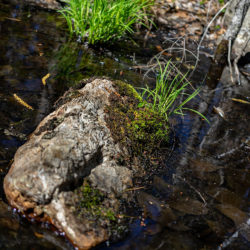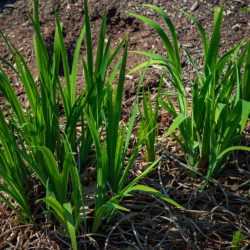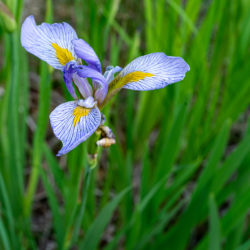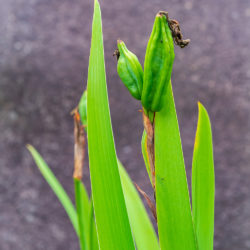Etymology
Iris is the Greek goddess of the rainbow; versicolor is Latin for variously colored. The common name ‘flag’ is from the Middle English word flagge, meaning rush or reed.
Native Habitat
Wet meadows, stream banks, marshes and swamps.
Garden Uses
Prefers moist to wet soil, growing well in rain gardens, marshes and on stream or pond banks, where it tolerates near-complete submergence. Generally care-free, and can also be easily grown and showy in sun to part-shade borders or naturalized in moist meadows.
Overview
This lovely purple iris is common in northern wetlands. Generally vigorous and easy to grow, it is clump-forming, with each clump spreading to 2-3 feet.
Leaves and Stems
Growing to a height of 2-3 feet, stems are sturdy and straight, while leaves are blade-like (lanceolate), approximately one inch at the widest mid-point and tapering on ends. Leaves rise both from a basal cluster and alternately on the stems, with edges set against the stem. Veins are parallel. Both leaves and stems are green to blue-green.
Flowers
Classic iris shape, in any shade of blue-violet to purple, or, rarely, white. The 3 outward curling petals (referred to as ‘falls’), may be veined with white, and generally each measure up to 2 inches in length. The 3 petal-like sepals (referred to as ‘standards’) are always yellow-based. The 3 broad pollen-receptive stigma cover the pollen-producing anthers, improving insect-mediated pollination. The ovary is below the base of the petal attachment. Typically 3-5 blooms occur consecutively or sequentially on each stem.
Fruit/Seed
Green to brown capsule, 1/2 to two inches long, splitting along 2 or more seams when dry to release 2 or more seeds.
Wildlife Associates
Popular with hummingbirds and insect pollinators. Poisonous to livestock. Deer tolerant. Can be damaged by iris borers.
Propagation
Spreads both by self-seeding and extensions of rhizomes. Easily propagated by seed or by division post-flowering, or in autumn.
Ethnobotanical Uses
Historically used for medicinal purposes, it is now identified as toxic to humans, and a source of both mild skin irritation on contact and digestive upset if ingested.
Garden Location
Library Garden (see garden map)
Anecdotal Information
Related native North American species include the smaller southern Iris virginica, and the Atlantic coastal Iris prismatica, which has slimmer, more grass-like leaves.
Sources
Lady Bird Johnson Wildflower Center
Plant Profile by Kate O’Dell





